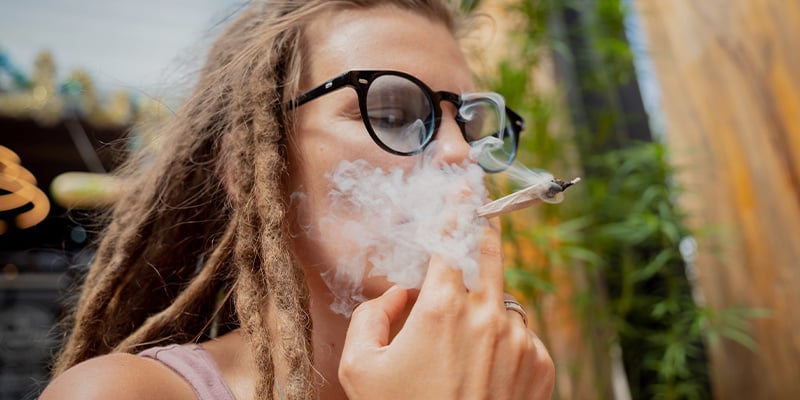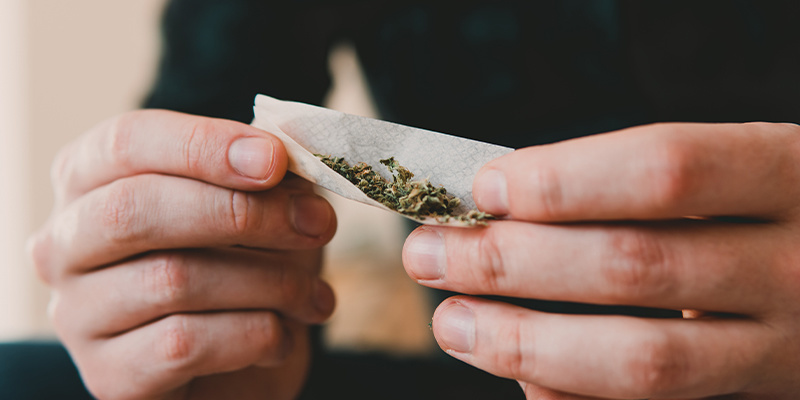
Weed paranoia explained: Why it happens and how to overcome it
Cannabis affects everyone differently. While it can help you relax, it may also cause paranoia—especially with high-potency strains or in stressful settings. In this article, we break down what causes weed paranoia, how long it lasts, and what you can do to avoid or manage it with confidence.
Cannabis doesn’t affect everyone the same way. While some people feel relaxed or uplifted, others may feel unsettled, anxious, or even scared. These uncomfortable feelings are often called weed paranoia. If you’ve ever felt like someone was watching you or judging you after smoking weed, you’re not alone. In fact, it’s more common than you might think.
This article explains what causes weed paranoia, how long it usually lasts, what the signs are, and how you can reduce or avoid it.
What is weed paranoia?

Weed paranoia is a state of irrational fear, mistrust, or unease that can occur after using cannabis. It goes beyond regular anxiety. People may feel like others are laughing at them, talking about them behind their backs, or even plotting against them—despite having no evidence or reason to believe so.
This is different from general anxiety, which may be long-lasting and not tied to any clear cause. Paranoia from weed usually comes on during or shortly after using cannabis and tends to fade once the effects wear off.
How long does weed paranoia last?
For most people, weed paranoia lasts between 30 minutes and a few hours. How long it remains depends on how much THC you’ve consumed, how you took it, and your personal tolerance. If you’ve smoked or vaped, the effects tend to peak and fade quicker. If you’ve taken an edible, the effects can last much longer—sometimes up to 6–8 hours.
Here’s a basic comparison between everyday paranoia and paranoia triggered by cannabis:
| Symptom | Regular Paranoia | Cannabis-Triggered Paranoia |
|---|---|---|
| Duration | Ongoing, lasting days or weeks | Temporary, fades after a few hours |
| Trigger | Psychological conditions or trauma | Directly after using weed |
| Intensity | Can be consistent or escalating | Often sharp but short-lived |
| Treatment | Requires long-term care | Often improves on its own |
Why does weed make you paranoid?
Not everyone feels paranoid after using cannabis, but when it does happen, there are a few key reasons behind it.
THC levels and dosage

The main compound in cannabis that produces psychoactive effects is THC (tetrahydrocannabinol). It affects parts of the brain that control memory, emotion, and perception. In small amounts, THC can make you feel relaxed. But at higher doses, it may overstimulate areas like the amygdala, which is involved in fear and stress.
Cannabis also contains CBD (cannabidiol), which doesn’t produce intoxicating effects, but it might help reduce some of THC’s side effects. If you’re using a strain with a high THC-to-CBD ratio, you’re more likely to experience paranoia from weed.
Individual sensitivity to THC
Everyone reacts differently to weed. Some people are more sensitive to THC than others, especially if:
- They have a lower body weight
- They’re using cannabis for the first time
- They take a large dose
- They have a history of anxiety
- They are female: studies suggest women may be more sensitive to THC due to hormonal differences (Craft, 2012)
Set and setting

Your mental state and surroundings also play a big role. If you’re feeling tense, stressed, or unsafe before using cannabis, your chances of feeling paranoid are higher. Being around strangers, loud noise, or unfamiliar places can also increase the risk.
On the other hand, if you’re in a familiar and relaxing setting with people you trust, you’re less likely to feel anxious or paranoid.
Your mindset before using weed can shape the entire experience. People who already feel socially anxious or self-conscious might find that cannabis amplifies those emotions. If you’re worried about how you’ll be perceived or already feeling on edge, even a small amount of THC can intensify those feelings. This is why intention and timing matter. If you’re using cannabis to unwind, but you're already under pressure or feeling uncertain, the experience may go in the opposite direction than you expect.
Signs of paranoia from weed

Not sure if what you’re feeling is weed paranoia? It helps to know the common symptoms so you can spot them early and stay calm.
Physical symptoms
- Racing heartbeat
- Sweaty palms
- Trembling or shaking
Mental symptoms
- Fear of being watched or judged
- Overwhelming sense of doom
- Unwanted or bizarre thoughts that don’t make sense
These symptoms can feel intense, but they’re usually short-lived. Most of the time, they go away once the effects of THC begin to fade. It helps to remind yourself that what you’re feeling is temporary and will pass.
How to overcome weed paranoia
Even if you start to feel paranoid, there are things you can do in the moment to feel better. You can also make a few changes to lower the chances of it happening again in the future.
Immediate steps

- Take deep breaths: Shallow, slow breathing helps reduce tension in the body. Try breathing in through your nose for four seconds, holding it, and breathing out through your mouth for six seconds.
- Change your environment: Move to a quieter, calmer location if possible. Being around people you trust can help settle your nerves.
- Drink water or lemonade: Hydration supports your body in metabolizing cannabinoids. Lemonade made with real lemon may help due to limonene, a compound that might reduce anxiety (Song, 2021).
- Whiff of black pepper: Smelling or chewing on a few black peppercorns may help reduce symptoms (E. A. Chayani Dilrukshi et al., 2024). Pepper contains some of the same terpenes as cannabis, which could help calm you down.
Long-term approaches

- Choose low-potency strains: Look for strains with a balanced cannabinoid ratio as CBD may help counteract paranoia caused by THC.
- Use alternative consumption methods: Smoking hits quickly and may overwhelm you. Try edibles, tinctures, or vaping for slower, more controlled effects.
- Choose the right dose: Always start low, especially if it’s a new product and increase the dose slowly if needed. Avoid taking large amounts all at once—this is one of the main reasons people experience paranoia from weed.
Finding balance with cannabis

Weed paranoia is a common reaction, especially with high-potency products or for people who are new to cannabis. It can feel overwhelming, but it’s nearly always temporary and something you can manage.
Understanding the causes, recognizing the signs, and making small changes to how, where, and what you use can make a big difference. Whether it's switching strains, adjusting your dose, or simply stepping outside for some fresh air, there are ways to keep yourself grounded.
If you’ve experienced weed paranoia before, it doesn’t mean cannabis isn’t right for you. With the right approach, many people find they can still enjoy its effects without the stress.
References:
Craft, R. M., Marusich, J. A., & Wiley, J. L. (2013). Sex differences in cannabinoid pharmacology: a reflection of differences in the endocannabinoid system?. Life sciences, 92(8-9), 476–481. https://pmc.ncbi.nlm.nih.gov/articles/PMC3492530/
E. A. Chayani Dilrukshi, Nishiyama, Y., Ito, K., & Nomura, S. (2024). Alleviation of acute stress response by black pepper aroma administration. Journal of Physiological Anthropology, 43(1). https://jphysiolanthropol.biomedcentral.com/articles/10.1186/s40101-023-00352-1
Song, Y., Seo, S., Lamichhane, S., Seo, J., Hong, J. T., Cha, H. J., & Yun, J. (2021). Limonene has anti-anxiety activity via adenosine A2A receptor-mediated regulation of dopaminergic and GABAergic neuronal function in the striatum. Phytomedicine : international journal of phytotherapy and phytopharmacology, 83, 153474. https://www.sciencedirect.com/science/article/pii/S0944711321000167?via%3Dihub
- Dilrukshi, E. A. Chayani, Nishiyama, Yuta, Ito, Kanetoshi, Nomura, & Shusaku. (2024, December). Alleviation of acute stress response by black pepper aroma administration - https://jphysiolanthropol.biomedcentral.com
- Rebecca M Craft, Julie A Marusich, & Jenny L Wiley. (2012 Jun 20). Sex differences in cannabinoid pharmacology: A reflection of differences in the endocannabinoid system? - https://pmc.ncbi.nlm.nih.gov
- Song, Y., Seo, S., Lamichhane, S., Seo, J., Hong, J. T., Cha, H. J., & Yun, J. (2021/03/01). Limonene has anti-anxiety activity via adenosine A2A receptor-mediated regulation of dopaminergic and GABAergic neuronal function in the striatum - https://www.sciencedirect.com
-
 6 min
March 17, 2025
What to do when you're too high on cannabis
We all get too high sometimes. It par for the course. However, it can help to know what to do when we get into this state, and knowing how to avoid it in the first place is vital knowledge, too.
6 min
March 17, 2025
What to do when you're too high on cannabis
We all get too high sometimes. It par for the course. However, it can help to know what to do when we get into this state, and knowing how to avoid it in the first place is vital knowledge, too.
-
 4 min
February 24, 2025
6 Cannabis strains with 1% THC or less
THC is the psychoactive cannabinoid, that makes marijuana users high. If marijuana contains very little of THC, can it still be an enjoyable experience? With these 6 strains on offer, with a THC...
4 min
February 24, 2025
6 Cannabis strains with 1% THC or less
THC is the psychoactive cannabinoid, that makes marijuana users high. If marijuana contains very little of THC, can it still be an enjoyable experience? With these 6 strains on offer, with a THC...
-
 3 min
June 23, 2022
6 Cannabis Strains To Make You Feel Talkative And Social
Some people find that weed helps them through a social setting. There are certain strains that can loosen your tongue and let the words flow. If you think cannabis can help you come out of your...
3 min
June 23, 2022
6 Cannabis Strains To Make You Feel Talkative And Social
Some people find that weed helps them through a social setting. There are certain strains that can loosen your tongue and let the words flow. If you think cannabis can help you come out of your...





 United States
United States










